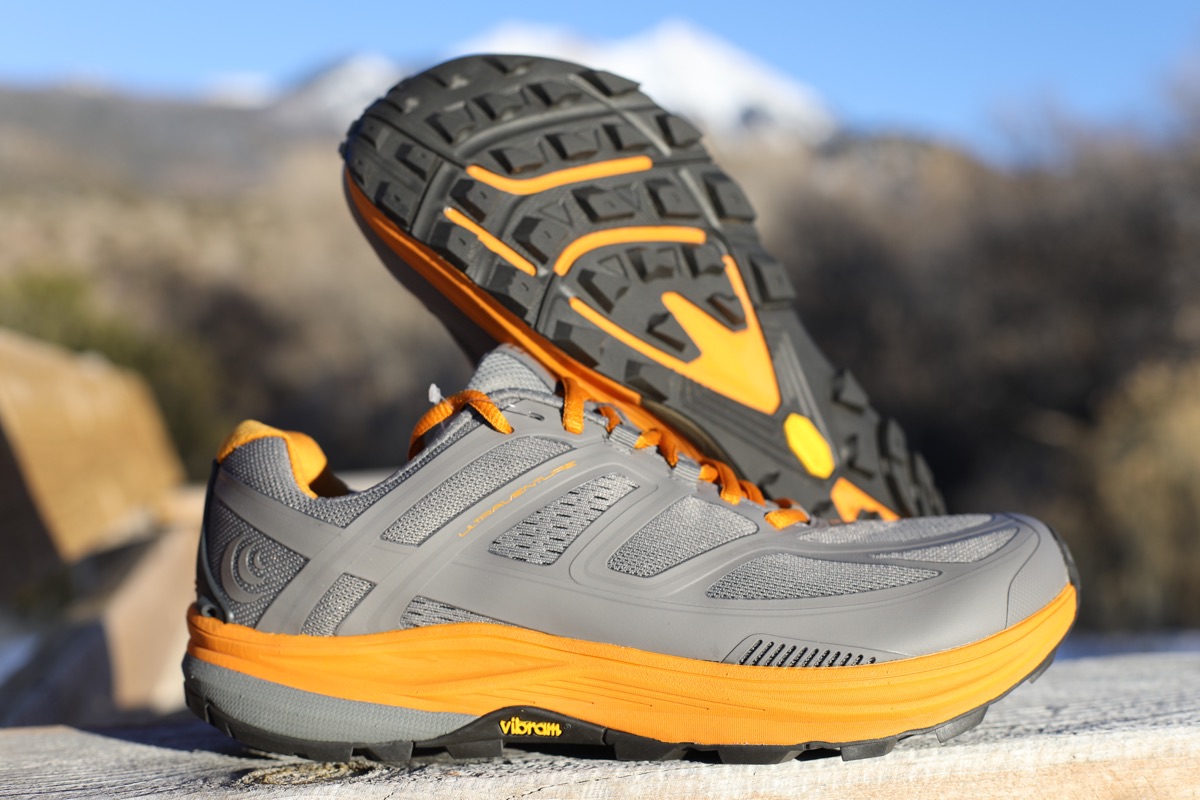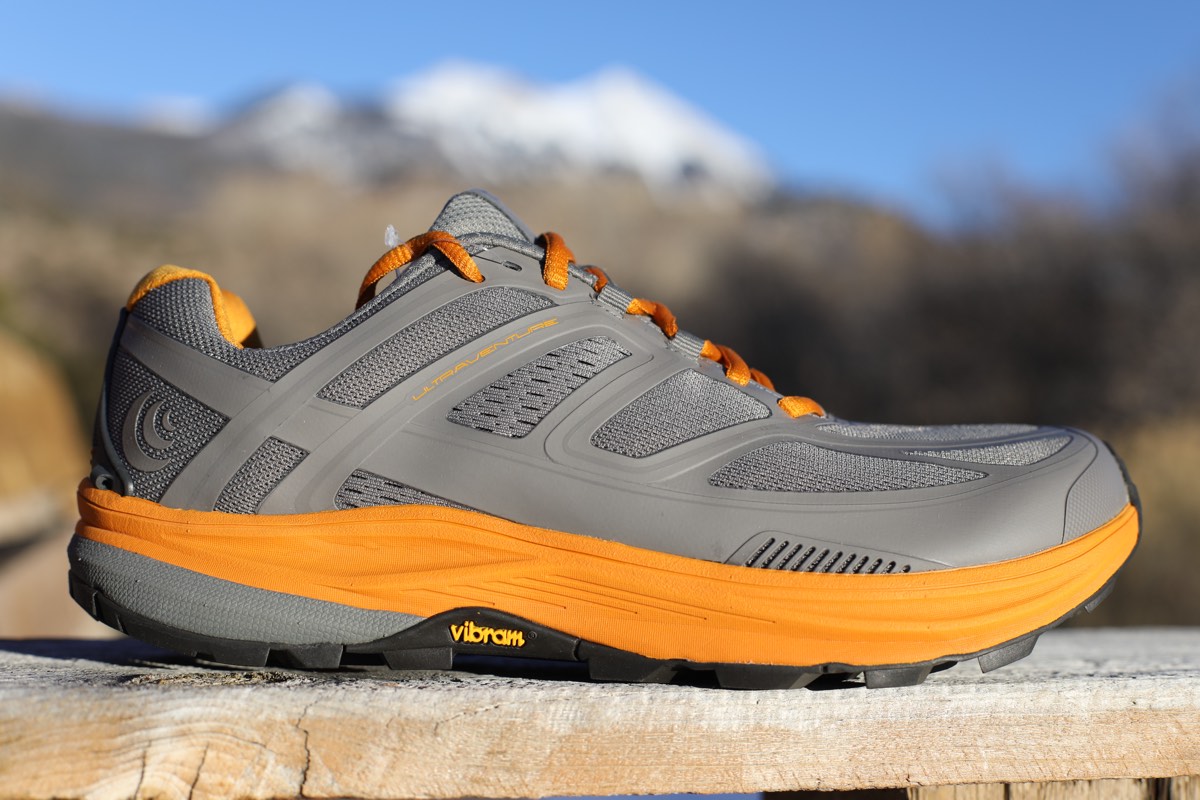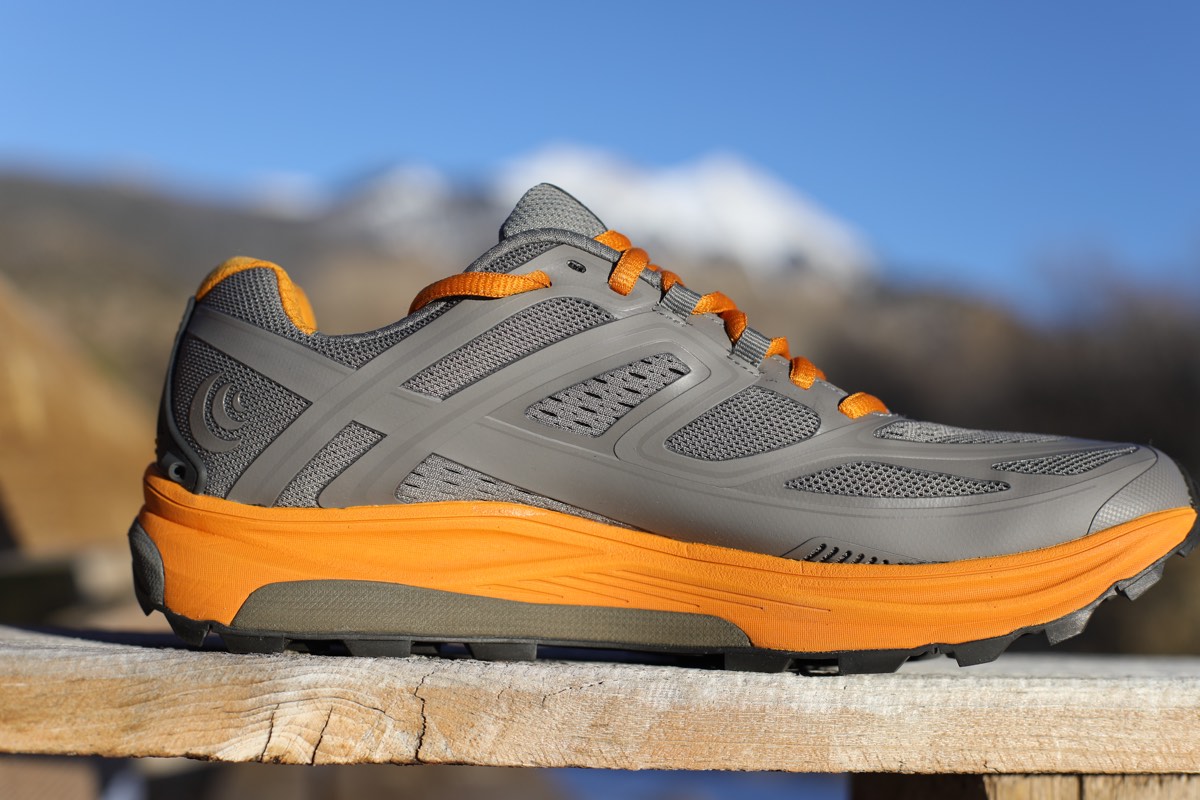For the latest on the Topo Ultraventure, check out our Topo Ultraventure 3 review.
Our Favorite Trail Running Shoes
Check out our Best Trail Running Shoes article to learn about our current favorite trail running shoes!
Topo Ultraventure Review
As running-shoe consumers, we are living in an exciting time where upstart companies can take on the long-established corporate behemoths and actually do fairly well. Trail running and ultrarunning, in particular, seem to be on the cutting edge of being willing to try new brands, and if a great shoe comes along the word of mouth spreads the news like wildfire. We were the early supporters of minimalist shoes, like the New Balance MT110 and much loved MT101 that led to multitudes of companies developing minimalist-style shoes. At the same time trail runners were trying Hoka One One models, like the Mafate and Bondi, that shaped the maximalist movement to come. Any runner who has attended a recent ultramarathon has seen the proportion of runners decked out in Altras with their foot-shaped fit and zero-drop technology.
At the same time, trail runners and ultrarunners seem to be the least brand loyal in the running crowd, and for good reason. Our sport itself tends to favor the stubborn and independent of humankind and we’re less likely to follow a brand due to clever marketing or the sponsorship of our favorite ultrarunner. This makes ultrarunners the perfect test kitchen of athletes to support new brands, new ideas, and even some absolutely quirky fads.
One of the people responsible for possibly the greatest quirky trail running fads, Vibram FiveFingers, is also responsible for a rapidly rising favorite among trail-shoe brands, Topo Athletic. A stalwart in the running-shoe industry, Tony Post was president of Vibram USA and spent 30 years in the shoe industry prior to launching Topo Athletic in 2013. Since its initial launch Topo has been turning heads with well-constructed and incredibly well-fitting running shoes, and their no-nonsense style and function seem to be catching on in the trail and ultra community.
I’ve had the pleasure of putting the Topo Ultraventure ($130) through its paces over the last six months, and while a running shoe might immediately make an impression with me, I find that it can be important to see how the shoe performs after months of running when the luster has faded. What follows is my honest take on an elegantly simple and long-lasting trail running shoe.
Topo Ultraventure Upper
One attribute of Topo shoes that seems to be almost universal since their first season’s offerings is a very dialed-in fit. For those unfamiliar with Topo shoes, the toebox is anatomically shaped (foot shaped) and accommodating without feeling sloppy. Topos always feel dialed in with my foot type and I think it has to do with the simplicity of their designs. A very durable mesh with welded-on overlays provides a supportive and locked-down fit that works well with the ghillie lacing system. What’s a ghillie lacing system? It’s just a cobbler’s word for a system of loops to route laces through to provide greater control in locking down the midfoot.
Refreshingly, the Ultraventure upper is devoid of obnoxious branding or colorways in an age which seems to be worshipping the 1990s. This is the type of running shoe that I’ll retire to casual wear for the sheer comfort of the last and shape. My only critical feedback on the Ultraventure upper is that the heel collar and cup is great fitting, but somewhat shallow. It worked well for my foot, although I could imagine some runners struggling with some slippage while ascending.
Topo Ultraventure Midsole
If you’re looking for a trail running shoe to overwhelm you with new midsole-foam technologies or carbon plates, the Ultraventure will not be your shoe. However, if you’re looking for a simple and effective trail shoe with a great blend of cushioning and fit, while at the same time providing all of the protection and ride you need for 100 miles, the Ultraventure may be your shoe. There aren’t any bells and whistles here, just a very functional and comfortable ride comprised of three layers of EVA at different densities. Some runners have compared it to the ride of the now-defunct Pearl Izumi Trail N2 and N3, and I agree with the comparison.
When I lace up the Ultraventure and start a run, I’m never initially blown away. However, after 30 minutes on the trail the Ultraventure starts to feel very smooth and more like a well-protected extension of my foot. With a stack height of 30mm (heel) and 25mm (forefoot), the Ultraventure doesn’t feel like a maximal shoe in any way, and it does feel nimble for a trail shoe weighing in at 10.5 ounces for a men’s size 9 and 8 ounces for a women’s size 7. The Ultraventure does not have a rock plate, and I’m not sure that one is needed. This is a shoe that excels at long distances on mild to moderate trails.
Topo Ultraventure Outsole
Vibram XS Trek Outsole runs the length of the Ultraventure with very few cutouts where EVA is vulnerable to sharp rocks. The relatively shallow multidirectional lugs shed snow and mud fairly well and they also allow the Ultraventure to work effectively as a door-to-trail, or hybrid, shoe. I was able to test the Ultraventure in muddy and snow conditions, but not in rainy conditions simply due to the fact that it rarely rains where I live. The Vibram outsole has exhibited excellent grip without showing much wear over the course of around 100 miles, and personally I did not have any issues with the lack of a rock plate.
Topo Ultraventure Overall Impressions
In my opinion, the Topo Ultraventure is a bit of a sleeper. It doesn’t have the kind of step-in plush comfort of a shoe like the Hoka One One Speedgoat 3, or the completely locked-in speedy feeling of a Salomon. If you tried it on at a running-shoe store you probably wouldn’t be very impressed. It’s a well-fitting shoe with a good deal of cushioning that just feels… pretty good. You don’t really realize the magic of the Ultraventure until you’re a few hours into a run and you realize that you haven’t thought about your shoes or feet at all. This shoe is a workhorse and it really functions on all types of terrain over all distances, and the Ultraventure is the type of shoe you could start and end a 100 miler in without issue. Additionally, the Ultraventure is a very solidly constructed shoe that I would expect to outlast 500 miles.
Topo Athletic as a company continues to impress, offering well-built and durable shoes that are simple and functional in their design. If you’re looking for an excellent-fitting shoe with a wide toebox, dialed-in fit, and a moderate drop, I would recommend giving one of their models a try.
Other Versions of the Topo Ultraventure
While we reviewed the men’s Topo Ultraventure in this article, be sure to also check out the Topo Ultraventure women’s version.
Call for Comments (from Meghan)
- Have you run in the Topo Ultraventure? If so, what are your thoughts on the shoe?
- Would you agree with reviewer Tom’s assessment of the shoe as a sleeper and workhorse that can be worn for long distances on mild to moderate terrain?
[Editor’s Note: If you’re affiliated (i.e., an employee, ambassador, etc.) with a brand, please share your relation in each of your comments on this article. Thanks!]





